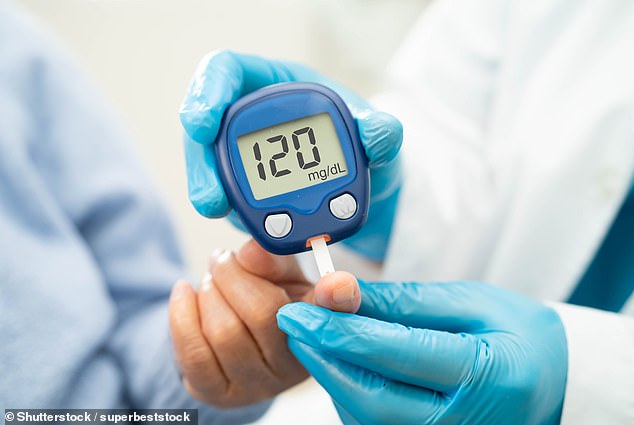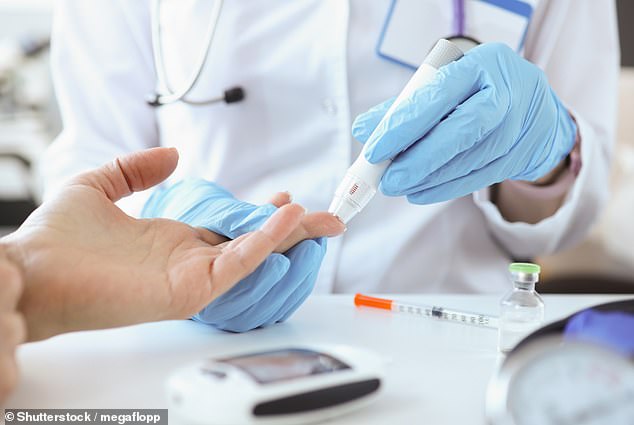- Oxford University researchers examined data on newly diagnosed diabetics
People diagnosed with type 2 diabetes before the age of 40 have a mortality rate four times higher than the general UK population, according to a study.
Those with early-onset disease also had a higher risk of complications such as blindness, limb amputation and kidney failure.
Researchers at the University of Oxford say their findings highlight the need to improve care for these patients and develop new drugs that can reduce harm.
They examined data from 4,550 newly diagnosed diabetics aged 25 to 65 over a period of up to 30 years.
The analysis revealed that adults with late-onset type 2 diabetes have a risk of death one and a half times higher compared to the general population.
The analysis revealed that adults with late-onset type 2 diabetes have a risk of death one and a half times higher compared to the general population (file image)

Oxford University researchers say their findings highlight the need to improve care for these patients and develop new drugs that can reduce harm (file image)
But this figure is multiplied by four among those diagnosed at a younger age, when the disease is usually more aggressive and takes longer to cause damage.
People diagnosed before age 40 also had a higher rate of diabetes-related complications, particularly microvascular diseases such as eye damage and kidney failure.
And a lower age at diagnosis was also associated with persistently worse blood sugar control.
Professor Amanda Adler, co-author of the study, said: “Over the last 30 years, the number of young adults diagnosed with type 2 diabetes has increased markedly around the world.
“Evidence to date suggests that earlier-onset type 2 diabetes, characterized by earlier and more prolonged exposure to elevated blood glucose levels, may be more aggressive than later-onset disease.”
This could include a more rapid decline in beta cell function (the cells in the pancreas that produce and release insulin) and an increased risk of complications such as cardiovascular and kidney disease.
“Lead author Dr Beryl Lin said: “Our data support the need to proactively identify young adults with type 2 diabetes and provide them with high-quality care across the lifespan.
“We urgently need clinical trials focused on young people to develop personalized treatments that prevent or delay complications, such as kidney and heart disease, and, crucially, reduce the risk of premature death.”

According to the study, people diagnosed before age 40 also had a higher rate of diabetes-related complications, particularly microvascular diseases such as eye damage and kidney failure (file image).
Diabetes UK estimates that there are more than 5.6 million people in the UK living with diabetes, which is an all-time high.
About nine in ten of them have type 2 diabetes, which is linked to unhealthy lifestyles.
The number of children and young adults (under 25) with type 2 diabetes increased by 54 per cent in England between 2016/17 and 2022/23.
The NHS spends at least £10bn a year on diabetes, making up around 10 per cent of its total budget.
Almost 80 per cent of the money the NHS spends on diabetes goes towards treating complications.
In some hospitals, more than a quarter of beds are used by people with diabetes.
In 2022/23, 66 million items were prescribed to people with diabetes in England, a figure up from 42.5 million a decade earlier.
The findings were published in The Lancet Diabetes and Endocrinology.
Helen Kirrane, head of policy and campaigns at Diabetes UK, said: “Diagnoses of type 2 diabetes in people under 40 are rising to alarming levels in the UK and it is very worrying to see more evidence that those who develop the disease at a younger age They are also more likely to die prematurely.
“The Government faces a generational opportunity to stop this health crisis as it begins to shape its 10-year plan for the NHS.”
We also need bold action to reverse the rise in type 2 diabetes, reverse our deteriorating food environment and give every child and young person the best possible chance to grow up in good health.’


